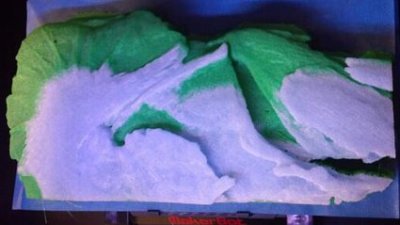Jan 7 2014
University of Oregon paleontologist Edward Davis and librarian Dean Walton are creating a three-dimensional printout of a rare saber-toothed salmon fossil using a special printer housed at the Science Library.
 Full 3-D printout of saber-toothed salmon fossil (courtesy, Ed Davis)
Full 3-D printout of saber-toothed salmon fossil (courtesy, Ed Davis)
Using a CT scan of the fossil as a digital model, the printer is generating a 3-D replica by melting layers of plastic and stacking them atop one another until the object is formed. After 70 hours of printing, the first piece of the printout — part of the lower jaw — was completed on Dec. 20. Three additional pieces will print in the coming weeks.
The fossil specimen includes the braincase, face and jaw of a 6- to 7-foot-long fish that inhabited Pacific Northwest waters about 5 million years ago. The specimen, uncovered in 1964 near Madras, Ore., is housed among the paleontological collections at the UO Museum of Natural and Cultural History (MNCH).
“After each piece has printed, we’ll glue the pieces together, and then use them to form a cast so that additional replicas can be made,” Davis said. “We couldn’t pull a cast from the actual fossil specimen because it’s so fragile, but now we have a way to do that — and to increase access to this striking animal by researchers, students and the public.”
The Science Library acquired the MakerBot-manufactured printer in November 2013, after Walton had learned about 3-D-printing technology and consulted with Kiersten Muenchinger, director of the UO Product Design program, about the benefits of housing a printer in the library. “We both thought it would be great to make this technology available to students and researchers on campus,“ Walton said.
Soon after, Science Library head Margaret Bean convened a team of staff members from the UO Libraries and the College of Art and Sciences to gather information and develop a proposal for acquiring a new printer.
“The great thing here is that the library is common ground on campus, so the MakerBot is a resource that all UO community members can use,” Walton said.
The saber-toothed salmon will play a starring role in the MNCH’s upcoming natural history exhibit, “Explore Oregon!” The cast formed from the completed printout will allow the fabrication of a realistic model that visitors to the museum will be able to examine and touch.